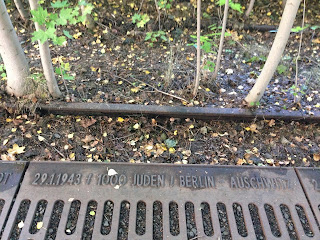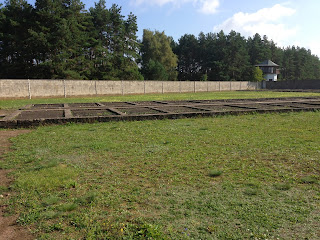Throughout Berlin there are many commemorative sites dedicated to the victims of National Socialism. There are so many you can literally stumble upon them. This museum is tucked away in what once was the thriving Jewish quarter of the city before the rise of Nazism. The museum is dedicated to Otto Weidt, the owner of a workshop for the deaf and blind. During the war years Weidt employed Jewish workers to prevent their deportation and produced brushes and brooms in the shop and today the museum is located in the old rooms of the workshop.
Friday, October 11, 2013
Gleis 17
My friends and I went to visit the memorial at the Grunewald rail station. Gleis 17 was the track used to transport most of Berlin's Jews to various destinations in the east after 1941. The station is located outside of the city center and came into use to hide the mass deportations from the rest of the populations.
Rough translation: "In remembrance of the 1941 - 1945 deportations by train to the death camps."
Along the platform were plaques with the date, number of people, and destination of each transport out of the Grunewald station between 1941 and 1945.
Unbekannt - Unknown
KZ Sachsenhausen
A few weeks ago I visited KZ Sachsenhausen, a Nazi concentration camp on the outskirts of Berlin. The camp was used by the Nazis from 1936 until the end of the war, at which time it became a Soviet camp for political prisoners (predominantly those who had committed war crimes during the Third Reich) until its closure in 1950. The camp was opened as a museum by the Soviets in the early 1960s, but the museum failed to commemorate the non-communist victims imprisoned there during the war years and instead commemorated the 'anti-fascist struggle' of the Soviet East against the Nazis. After German reunification the memorial was expanded to include all victims of the camp during World War II. Sachsenhausen was one of the earlier and smaller of the Nazi concentration camps and just to clarify, this camp was not an extermination camp. Although thousands of people died here, it was not established as a death camp as those in the East were. This is a very basic overview of the history of this camp.
I'm not sure one can write a response or reaction to visiting the camp. There are no words to accurately describe the feeling of being at a place like this and knowing what happened here. Besides, who am I to tell a story I will never understand? No words that you or I could ever come up with would do justice to the victims or survivors of any of the camps. So go listen to a survivor speak. They are the ones to tell these intimate stories.
So, in the absence of words, these are some images from the camp.
Thursday, September 12, 2013
Live Life Outside Your Comfort Zone
Having been In Europe for exactly one month and living with my family now for almost three weeks, I have a whole new respect and appreciation for how difficult it can be to try to assimilate yourself into a new culture, a new language, a new everything. I would say, generally speaking (and yes, I know it can be risky to generalize), but generally speaking the transition from American culture to German culture is probably one of the easier transitions as opposed to, say, going to live in the Middle East or Turkey, India or Asia. But even so, there are still difficulties. I still believe we have a huge illegal immigration problem in the United States, but to those that do it the legal way and actually work to be a successful and productive member of society, I have a much greater respect for how difficult it can be to live in a foreign society.
Having said that, I must also say that every part of being here is beautiful. Difference is a wonderful thing. Now I've been sitting here staring at the screen for the last seven minutes trying to figure out just the write word to describe how I feel since having been here. Sometimes I get frustrated with the language (specifically with German grammar, my brain doesn't process these things nearly as quickly as I would like it to), but when it clicks, or when I can fully understand something that is said to me without having to translate it into English in my head before responding, it feels like a momentous achievement. And aside from the language, I learn new things everyday. Little things. Things that you wouldn't catch if you weren't really paying attention. Things about people, about culture, about food, about everything. So I guess in being here I feel more whole. Like as a human being I am becoming more whole...
Wednesday, September 11, 2013
Nürnberg
This past weekend I went with two of my friends, Michelle and Morgan, to Nürnberg, but first we went to the Fassbender & Rausch chocolate factory. They had chocolate models of everything, cars, planes, animals, the Reichstag, the Brandenburger Tor, everything.
This was my raspberry cake, it was delicious. So delicious!
Then we went to Nürnberg. It was such a cute little city! It was bombed during the war just like Berlin was, but when they rebuilt it they did it in a way that retained the style of the old city. It definitely doesn't have the more modern feel that Berlin has. Michelle and I stayed in a hostel, my first hostel experience! It wasn't nearly as sketchy as I had thought it was going to be. But we did keep reminding each other of the movies "Hostel" and "Taken", and we creeped each other out. But it was a nice place. Pretty clean, and the breakfast they had was delicious, a butter croissant with strawberry jam and of course butter (by the way German butter is 1,000,000 times better than the butter in the US). Michelle and I swear that our 'roommate' was trying to steal her identity. She was a girl traveling around Germany from China, and she told Michelle "you have my face", followed by prying questions about her life, i.e. conversation for the immigration officers. Good thing our passports were being registered with the authorities that weekend so we didn't have them. Needless to say Michelle slept with the rest of her IDs under her pillow that night ;) Here is a picture of the road our hostile was on, that wall was rebuilt after the war, it was originally a fortification wall.
The first night we were in Nürnberg we just walked around the city center.
This fountain was huge in person and is a story. Each side tells a different part of it.
And this is the stone that told the story of said fountain. Apparently the fountain was a depiction of the relationship some guy had with his wife. Um, can we just take another look at the fountain?? Talk about a love/hate relationship...
This store was called "Closed". That's an interesting name for a store...
This city is ridiculously beautiful.
Can I just live here forever?
But they do have some creepy artwork. This rabbit was rooting. And if you looked closer there are other smaller, starved rabbits coming out of the big rotting rabbit.
In the morning we headed up to the castle. On the way we passed a little antique store and decided to go in. In the back of the shop there was some military stuff I wanted to take a look at. So we all walk back there and it's pretty much all Nazi memorabilia. There was a Luftwaffe uniform and various other parts of the military uniforms out of the Third Reich. And not to mention the pictures of Hitler, that I'm pretty sure could have been used as propaganda. And there is also the small fact that I'm pretty sure all that stuff is illegal to have and especially illegal to sell in Germany. It was weird and a bit unsettling.
When we got onto the castle grounds we had to walk through this really cool, old looking tunnel.
Panoramic of the grounds
That's a cool looking pistol.
If I was a horse and you put one of these things in my mouth I would tell you to get the hell off of me...
We climbed this. I got dizzy. But the view from the top was totally worth it.
View from the top of the watch tower.
After the castle we went to the courthouse where the Nürnberg Trials were held. This was where some of the top Nazi war criminals were tried and sentenced.
Courtroom 600, where the trial took place. Sitting in there you got an unsettling feeling, knowing that such evil people had sat in that very room. And knowing what they were there for and the crimes they had committed...
Courtroom 600 in 1945 versus now.
Allies and chief prosecutors of the trials, The United States, United Kingdom, Russia, and France.
The actual benches that the Nazis sat on while the trial took place. This is where they were sitting when they received their sentences.
And in the train station (on the way to the documentation center) we just had to stop and get Mars Bars. They are so delicious!
The Dokumentationszentrum in Nürnberg. This was the sight of the Nazi rallies.
Panoramic picture of the 'stadium' that the rallies were held in, it was a huge space.
This is a memorial inside the now museum to the victims of the Holocaust. There are 10,000 cards, each with a name, birthdate, birthplace, death date, and death place. Each of the 10,000 cards represents 100 people.
There is something incredible about actually getting to see these places. It's one thing to read about them in books or learn about them in class. But to go see them, that makes it real.
Subscribe to:
Posts (Atom)













































































